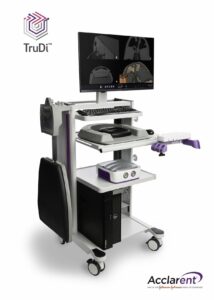 Balloon Sinuplasty opens blocked sinus cavities in four easy steps:
Balloon Sinuplasty opens blocked sinus cavities in four easy steps:
Balloon Sinuplasty is a breakthrough procedure that relieves the pain and pressure associated with chronic sinusitis. It is used by surgeons to safely and effectively treat chronic sinusitis patients who are not responding well to medications such as antibiotics, nasal steroids, or over‐the‐counter (OTC) drugs, and are seeking relief from uncomfortable and painful sinusitis symptoms.
Similar to how angioplasty uses balloons to open blocked arteries, Balloon Sinuplasty, a system of FDA‐cleared, catheter‐based instruments, opens blocked sinuses.
The procedure is less invasive than traditional sinus surgery. It allows most patients to return to normal activities quickly.
With Balloon Sinuplasty, a specially‐designed catheter is inserted into the nose to reach the inflamed sinus cavity. A small balloon is slowly inflated, which widens and restructures the walls of the sinus passage, helping to drain mucus from the blocked sinus and restore normal sinus drainage without cutting and with minimal bleeding. This approach also preserves the natural structure of the sinuses.
Published clinical data shows that Balloon Sinuplasty provides symptom relief for the majority of patients:
Balloon Sinuplasty is performed under general anesthesia in an outpatient setting; however, some surgeons are choosing to treat certain patients in their office under local anesthesia. The reported complication rate for Balloon Sinuplasty is low.
Patients who suffer from chronic sinusitis and are not responding well to medications may benefit from seeing an Ear, Nose, and Throat (ENT) physician who performs Balloon Sinuplasty to determine if the procedure is right for them. Most insurance companies and Medicare provide coverage for Balloon Sinuplasty.
Balloon Sinuplasty has been used to treat more than 330,000 patients since receiving FDA clearance.
For more information about Balloon Sinuplasty, visit www.balloonsinuplasty.com
Balloon Sinuplasty is intended for use by or under the direction of a doctor. There are associated risks, including tissue and mucosal trauma, infection, or possible optic injury. Interested individuals should speak with their doctor about the risks and benefits and to determine whether Balloon Sinuplasty is right for them.
 Dr. Timothy Gillum and his team at Gillum Sinus & Allergy Institute are the first in Indiana to bring TruDi 3D navigational technology to the office setting. This technology provides improvement to sinus procedures, such as balloon sinuplasty, by providing increased safety and accuracy during the procedure in real-time. This decreases the chance for complications and improves overall outcomes which can reduce the possibility of needing revision procedures or additional surgery in the future.
Dr. Timothy Gillum and his team at Gillum Sinus & Allergy Institute are the first in Indiana to bring TruDi 3D navigational technology to the office setting. This technology provides improvement to sinus procedures, such as balloon sinuplasty, by providing increased safety and accuracy during the procedure in real-time. This decreases the chance for complications and improves overall outcomes which can reduce the possibility of needing revision procedures or additional surgery in the future.
TruDi is like “GPS” for your sinuses. This allows Dr. Gillum to know exactly where he is in your sinuses during your procedure. Not only is this a major improvement in his ability to safely do your procedure, but it also allows for better outcomes. Often when you have a congested sinus that needs to be opened, the natural opening can be less than 1 millimeter in size. When working in such a tight space, TruDi allows Dr. Gillum to direct the sinus instruments in the appropriate direction which results in a safer procedure and decreased need for revision procedures in the future.

Copyright © 2020. All Rights Reserved
Monday – Thursday
9:00AM – 5:00PM EST